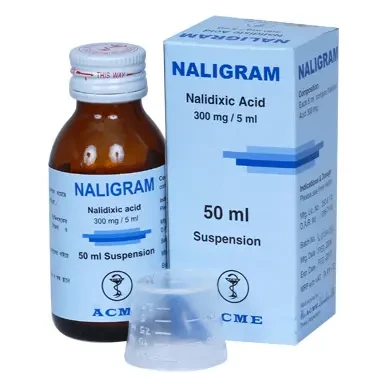50 ml bottle:
৳ 43.13
100 ml bottle:
৳ 86.36
Also available as:
Indications
Naligram is indicated in the treatment of urinary tract infection caused by susceptible Gram-negative organisms, including Proteus species, Klebsiella species, Enterobacter species and Escherichia coli.
* রেজিস্টার্ড চিকিৎসকের পরামর্শ মোতাবেক ঔষধ সেবন করুন
Pharmacology
Nalidixic acid is a synthetic narrow spectrum antibacterial. It is bacteriostatic or bactericidal depending on the concentration. Nalidixic acid appears to act by inhibiting bacterial DNA synthesis, possibly by interfering with DNA polymerization. It is rapidly and completely absorbed from the G.I. Tract. Parent drug and active metabolites are distributed to most tissues specially to the kidney and to the urine. During normal renal function, half-life is 1.1 to 2.5 hours and when renal function is impaired, half-life is up to 21 hours. It is rapidly and almost completely excreted within 24 hours.
Dosage & Administration
Adult: initially is 1 g every 6 hours for 7 days reducing to 500 mg every 6 hours.
Children: Infants and children 3 month of age and over Initial: Oral 13.75 mg per kg body weight every six hours for one or two weeks. Maintenance: Oral 8.25 mg per kg body weight every six hours or as prescribed by the physician.
Children: Infants and children 3 month of age and over Initial: Oral 13.75 mg per kg body weight every six hours for one or two weeks. Maintenance: Oral 8.25 mg per kg body weight every six hours or as prescribed by the physician.
* রেজিস্টার্ড চিকিৎসকের পরামর্শ মোতাবেক ঔষধ সেবন করুন
Interaction
Concomitant use of Naligram with melphalan there have been reports of death froms severe blood containing diarrhoea caused by hemorrhagic ulcerative colitis. Probenecids inhibits tubular secretion of Naligram and may therefore elevate serum concentration, possibly enhancing toxicity. Chlorpromazine and Perphenazine have been shown to potentiate the effect of Naligram in vitro.
Contraindications
Nalidixic acid is contraindicated in the following cases- Infants under 3 months, epilepsy, CNS lesions.
Side Effects
Gastro-intestinal disturbances including nausea, vomiting, diarrhoea, haemolysis in G6PD deficiency, allergic reaction including urticaria, rashes, fever, arthralgia, eosinophilia, also myalgia, muscle weakness, phototoxicity, jaundice, visual disturbances and convulsions.
Pregnancy & Lactation
There is the possibility that it may cause cartilage damage and as it is a DNA-gyrase inhibitor there is a possibility of causing DNA damage too. Nalidixic acid is excreted in breast milk and there is a report of hemolytic anaemia in a breast feed child of an azotemic mother.
Precautions & Warnings
Risk-benefit must be considered during the first trimester of pregnancy and during breast feeding, impaired renal or hepatic function.
Therapeutic Class
Anti-diarrhoeal Antimicrobial drugs, Other Anti-protozoals, Systemic Urinary Anti- infective
Storage Conditions
Keep below 30°C temperature, away from light & moisture. Keep out of the reach of children.

